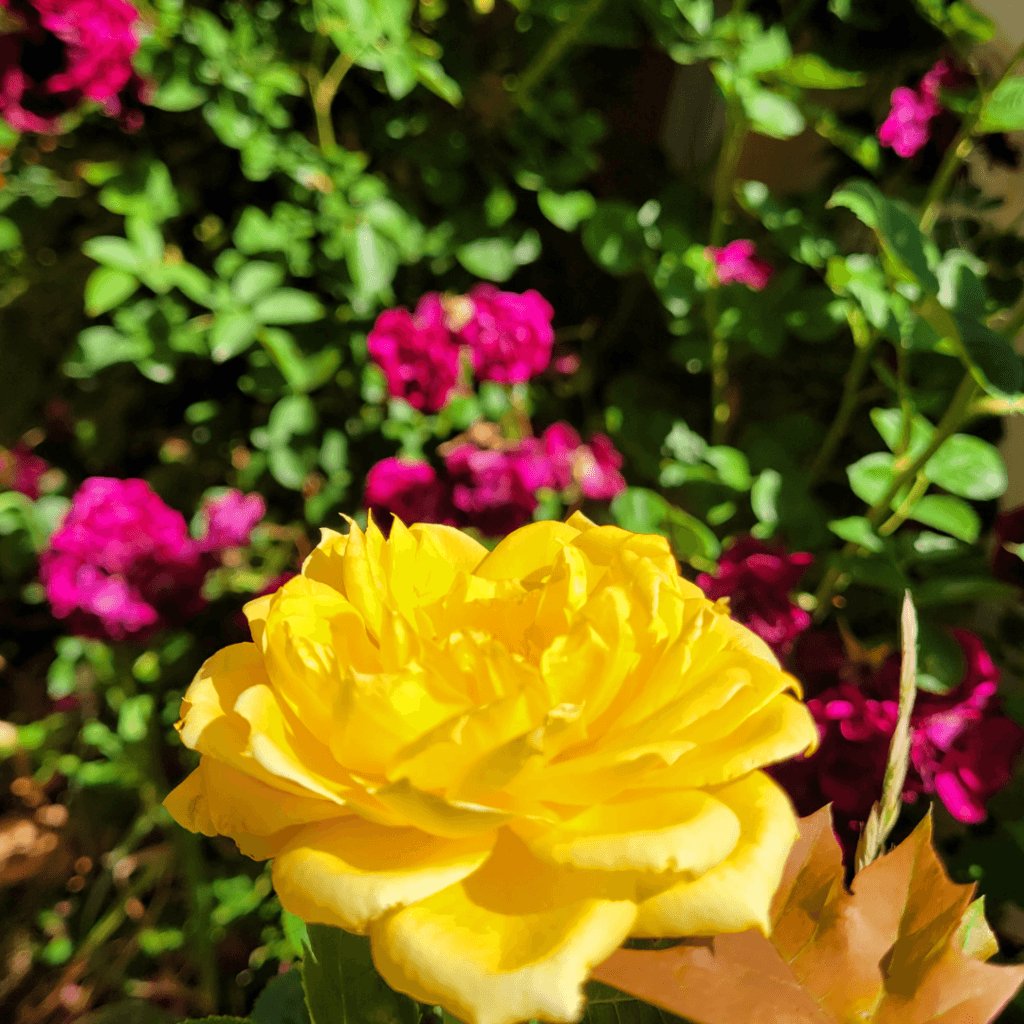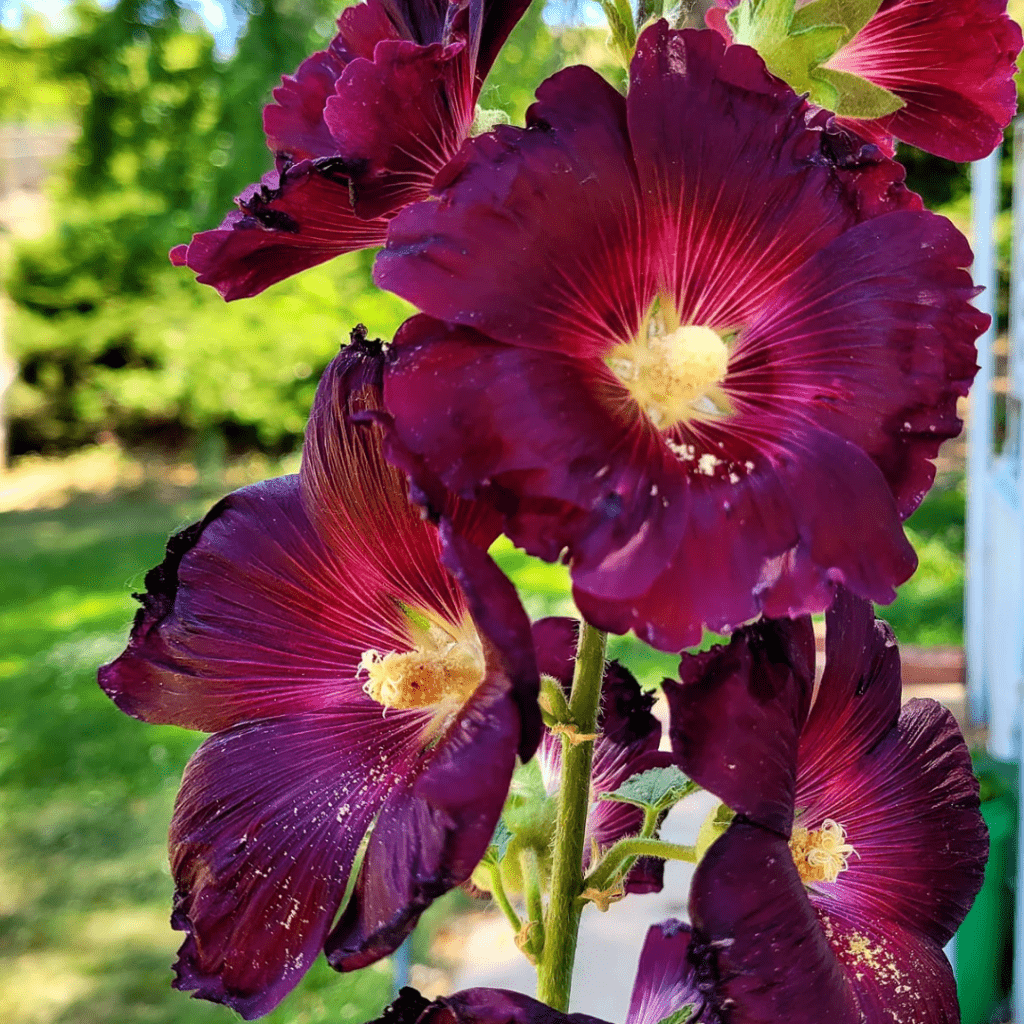Flower garden.
Embarking on the journey to cultivate your dream flower garden is a rewarding and fulfilling endeavor that allows you to bring beauty and nature into your outdoor space. This comprehensive guide is designed to equip you with the knowledge and tools necessary to plan, plant, and maintain a flourishing flower garden that reflects your unique style and preferences. From selecting the perfect flowers for your garden to implementing sustainable practices and overcoming common challenges, each aspect of flower gardening is explored to help you create a vibrant and thriving oasis. Whether you are a novice gardener or a seasoned enthusiast, this guide will inspire and empower you to transform your outdoor space into a captivating floral paradise!
This is a pinnable post. Tap or hover over any image in this post to pin to your Pinterest Boards.
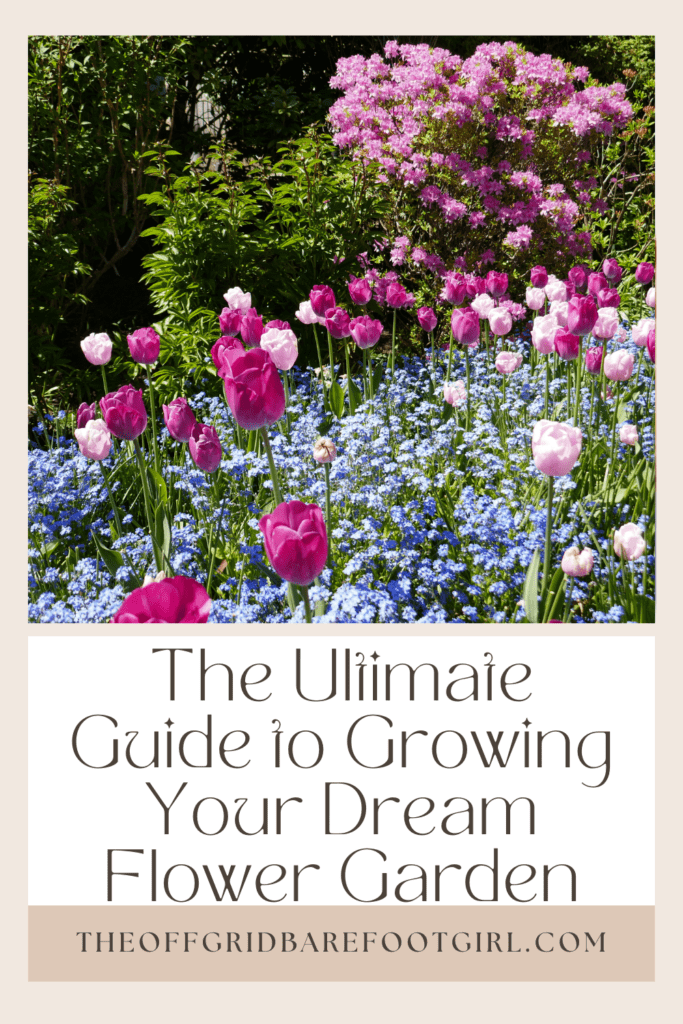
Planning Your Dream Flower Garden
So, you’ve decided to dive headfirst into the whimsical world of flower gardening. Before you start planting away, let’s chat about some key initial steps to ensure your garden dreams blossom into reality. So grab a cup of coffee or tea and let’s talk about flowers!
Why I Love Growing a Flower Garden!
I have been growing flowers for about six years. I adore a mixture of bright and colorful flowers in my cottage garden. It brings me so much joy to see each of the varieties sprouting and blooming at different seasons of the year. I love watching the cottage garden change each year as the perennial flowers move around to the spaces they want to occupy for that season and spread out to create beautiful spaces. The garden is alive and the plants move around and enjoy different parts of the garden each year. I allow them to do their own desire since they bring me so much delight. Throughout the remainder of this post, you will see images of my prized flower garden!
You can learn more about what I am talking about in my post about my flourishing cottage garden and how the cottage garden changes on its own each year where I discuss this in further detail in the following link.
How to Design a Cottage Garden: Growing a Beautiful Mess
But you can also continue reading here about growing the garden of your dreams.
Assessing Your Garden Space and Sunlight
First things first, take a good ol’ gander at your outdoor oasis. How much space do you have to play with? Are there any shady spots or is it a full-on sun fest? Understanding your garden’s layout and sunlight patterns will help you choose the right flowers that’ll thrive in their new digs.
Assessing your garden space and sunlight is crucial for planning a successful garden. Here’s a step-by-step guide to help you:
- Observe Sunlight: Spend some time in your garden throughout the day to observe how sunlight moves across the space. Note areas that receive full sun, partial sun, or shade.
- Sun Chart: Create a simple chart or map of your garden space and mark areas based on sunlight exposure. You can use symbols or colors to differentiate between full sun, partial sun, and shade. Do this during different parts of each season.
- Sunlight Requirements of Plants: Different plants have different sunlight requirements. Research the sunlight preferences of the plants you intend to grow. Some may require full sun (at least 6 hours of direct sunlight per day), while others thrive in partial sun or shade.
- Orientation: Consider the orientation of your garden space concerning the sun’s path. South-facing gardens generally receive more sunlight throughout the day, while north-facing gardens may have more shade.
- Obstacles: Identify any obstacles that may block sunlight, such as trees, buildings, or tall structures. These can create shade patterns in your garden.
Environmental Elements
- Microclimates: Your garden may have microclimates, which are small areas with unique temperature and sunlight conditions. These can be influenced by factors like nearby walls, water features, or slopes. Identify these microclimates and understand how they affect sunlight exposure.
- Seasonal Changes: Keep in mind that sunlight patterns can change with the seasons. A spot that receives full sun in the summer may become shaded in the winter due to changes in the sun’s angle.
- Test Soil Moisture and Drainage: While assessing sunlight, also evaluate soil moisture and drainage in different areas of your garden. Soil that retains too much water or drains poorly may not be suitable for certain plants, regardless of sunlight levels.
- Adaptation: Be prepared to adapt your garden layout and plant selection based on your observations. You may need to adjust the placement of plants or choose different varieties that better suit the sunlight conditions in your garden.
By carefully assessing your garden space and sunlight, you can optimize plant growth and create a thriving garden environment.
Determining Your Garden Style and Theme
This is my favorite part of creating a flower garden! Picking out and planning for a variety of flowers and colors to make my flower garden pop brings me so much happiness!
What about you? Are you going for a wild, untamed jungle vibe or more of a symmetrical, organized look? Maybe you’re feeling whimsical with a cottage garden theme, like me! Whatever floats your garden boat, deciding on a style will guide your plant choices and create a cohesive, Instagram-worthy garden aesthetic!
Determining Your Personal Preferences
Determining your flower garden style and theme involves considering your personal preferences, the surrounding landscape, and practical factors like climate and sunlight conditions. Here’s how you can go about it:
- Personal Preferences: Start by identifying your favorite colors, flower types, and overall aesthetic preferences. Do you prefer vibrant and bold colors, or do you lean towards a softer, pastel palette? Are you drawn to specific flower shapes or textures?
- Research: Look for inspiration in gardening books, magazines, websites, and social media platforms like Pinterest or Instagram. Explore different garden styles and themes, such as cottage gardens, formal gardens, wildflower meadows, or Japanese gardens. Pay attention to the plant combinations, layout designs, and decorative elements that appeal to you.
- Consider the Landscape: Assess the existing landscape features of your garden, including its size, shape, topography, and architectural elements. Choose a garden style and theme that complements the overall character of your landscape. For example, a cottage garden might suit a quaint suburban backyard, while a minimalist modern garden might be more appropriate for a contemporary urban space.
- Climate and Growing Conditions: Take into account your local climate, soil type, and sunlight exposure when selecting plants for your garden. Choose flowers and foliage that are well-suited to your growing conditions to ensure their success. You can also consider incorporating native plants, which are adapted to the local environment and require less maintenance.
Design and Functionality
- Unity and Cohesion: Aim for unity and cohesion in your garden design by selecting plants and decorative elements that harmonize with your chosen style and theme. Choose a consistent color scheme, plant height, and texture to create a cohesive look throughout the garden.
- Functional Considerations: Think about how you intend to use your garden space and any functional requirements you may have. Do you want a garden that attracts pollinators, provides privacy, or serves as a relaxing retreat? Incorporate elements like seating areas, pathways, or water features to enhance the functionality and enjoyment of your garden.
- Experiment and Adapt: Don’t be afraid to experiment with different plant combinations and design ideas as you develop your garden style and theme. Gardening is a creative process, and your garden can evolve over time as you learn and adapt to changing preferences and conditions.
Ultimately, the most important aspect of determining your flower garden style and theme is to create a space that brings you joy and reflects your personality and vision. Have fun exploring different possibilities and let your creativity guide you in designing a beautiful and unique garden.
Selecting the Perfect Flowers for Your Garden
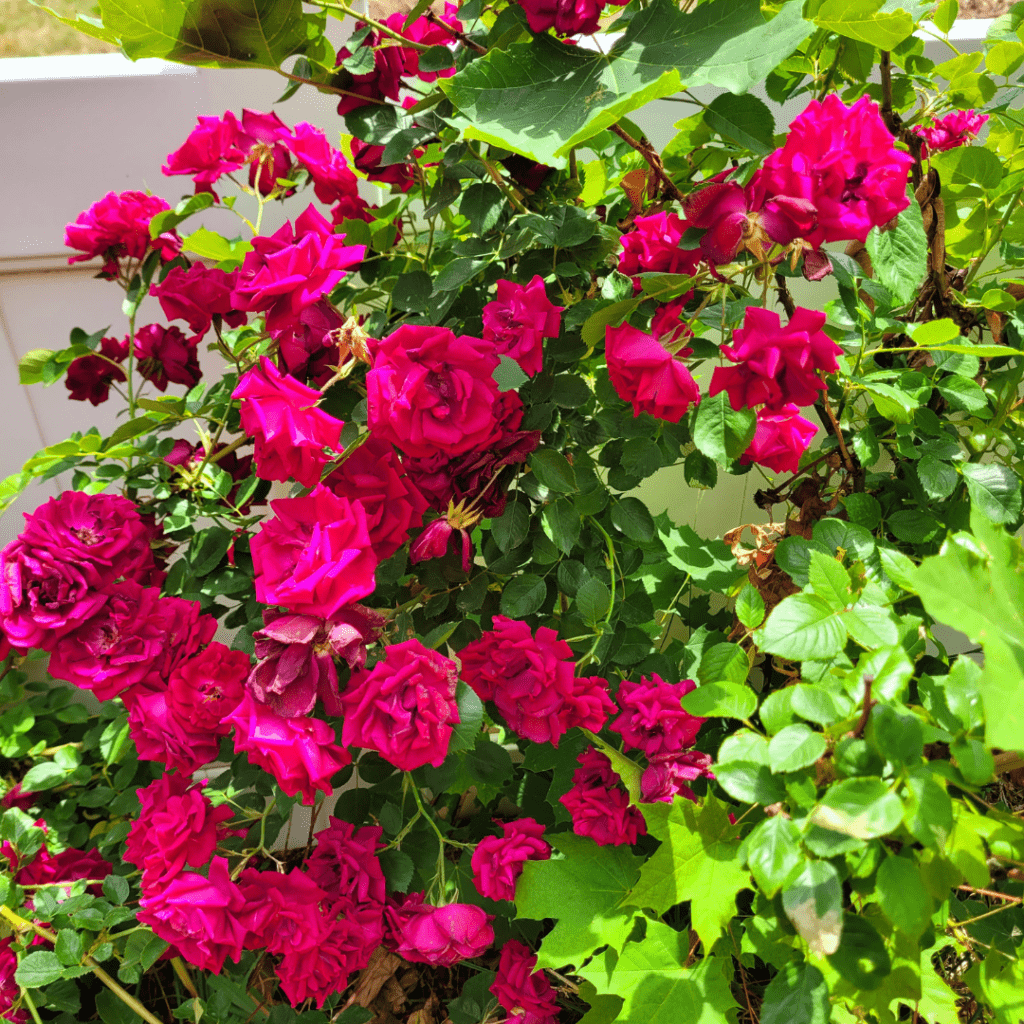
Now that you’ve got the lay of the land (literally), it’s time to pick out the stars of your floral show. Keep in mind your garden’s climate and seasonal changes to ensure those blooms stay bloomin’ all year round!
Understanding Your Growing Zone and Climate
Don’t let your plants get a frosty reception or a sweaty meltdown. Know your garden’s growing zone and climate, so you can choose flowers that’ll thrive in your specific environment. Happy plants = happy gardeners.
Understanding your growing zone and climate is essential for successful gardening, as it helps you select plants that are well-suited to your local conditions. Here’s how you can do it:
- Identify Your USDA Hardiness Zone: The USDA Hardiness Zone Map divides North America into 13 zones based on average annual minimum winter temperatures. Each zone is further divided into subzones (a, b, etc.). Determine your zone by finding your location on the map. This information is crucial because it helps you choose plants that can withstand the lowest temperatures in your area.
- Research Your Climate: In addition to your hardiness zone, consider other climatic factors such as average annual rainfall, humidity levels, frost dates, and length of the growing season. This information gives you a more comprehensive understanding of your local climate and helps you make informed decisions about plant selection, irrigation, and frost protection.
- Consult Local Resources: Local gardening centers, cooperative extension offices, botanical gardens, and gardening clubs are valuable resources for understanding your growing zone and climate. They can provide region-specific gardening advice, recommended plant varieties, and tips for dealing with local challenges such as pests, diseases, and soil conditions.
Observation Is Key In a Successful Flower Garden
- Observe Microclimates: Within your garden or landscape, there may be microclimates—small areas with unique temperature, sunlight, and moisture conditions. Observe how sunlight, shade, wind patterns, and topography affect different parts of your property. This information helps you choose the best planting locations for various types of plants.
- Keep Records: Keep a gardening journal or use a gardening app to record observations, planting dates, weather patterns, and plant performance throughout the year. Over time, you’ll develop a better understanding of your local climate and how it influences your garden.
- Choose Climate-Appropriate Plants: Select plants that are well-adapted to your growing zone and climate. Consider factors such as temperature tolerance, water requirements, and sunlight preferences when choosing plants for your garden. Native plants and cultivars bred for local conditions often perform best in their native climate.
- Practice Climate-Resilient Gardening: As climate change continues to impact weather patterns, it’s important to practice climate-resilient gardening techniques. This may include water-wise gardening, soil conservation, mulching, selecting drought-tolerant plants, and implementing strategies to protect plants from extreme temperatures, storms, and other climate-related challenges.
You can read more about planting a climate-friendly garden in my post where I discuss this in further detail.
How to Plant A Climate-Friendly Garden: Strategies for Beginners
By understanding your growing zone and climate, you can make informed decisions about plant selection, garden design, and maintenance practices, leading to a more successful and enjoyable gardening experience.
Choosing Flowers for Different Seasons
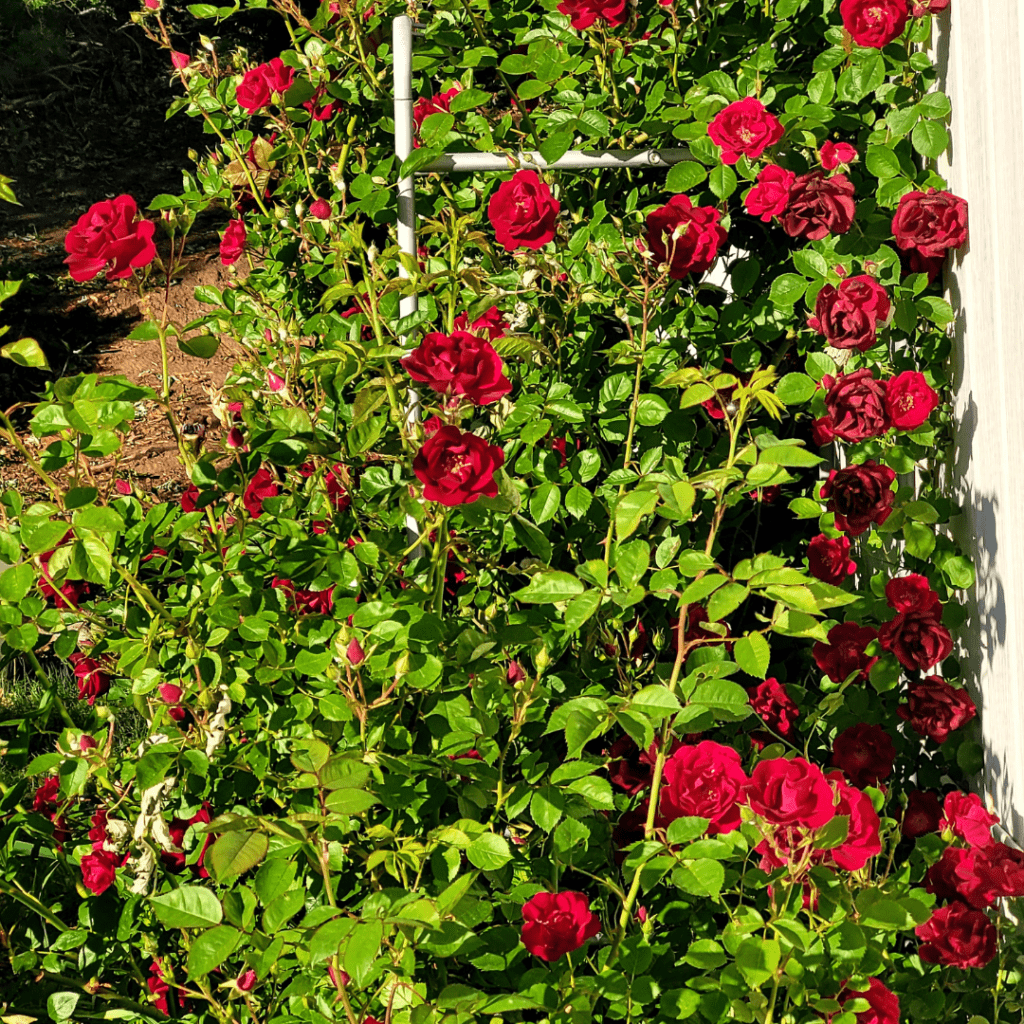
Who says flowers are a one-season wonder? Mix and match your blooms to have a colorful garden extravaganza all year long. From spring tulips to winter pansies, there’s a flower for every season and every gardener.
Choosing flowers for different seasons allows you to enjoy continuous blooms and color in your garden throughout the year. Here are some flower suggestions for each season:
Spring
- Tulips: These iconic spring flowers come in a variety of colors and bloom shapes, adding vibrant hues to your garden.
- Daffodils: With their cheerful yellow or white blooms, daffodils are a classic spring flower that signals the arrival of spring.
- Hyacinths: Known for their fragrant clusters of flowers, hyacinths come in a range of colors and add beauty and scent to spring gardens.
- Pansies: Pansies are cold-hardy annuals that bloom profusely in spring, offering a wide range of colors and patterns.
- Lilacs: Lilac shrubs produce fragrant clusters of purple, pink, or white flowers in spring, filling the air with their sweet scent.
Summer
- Roses: Summer is the peak season for roses, which come in a vast array of colors, sizes, and fragrances, making them versatile additions to any garden.
- Geraniums: These popular annuals produce clusters of colorful flowers throughout the summer, thriving in sunny locations with well-drained soil.
- Lilies: Asian and Asiatic lilies bloom in summer, adding elegance and beauty to the garden with their large, showy flowers.
- Sunflowers: Sunflowers are iconic summer blooms known for their cheerful yellow petals and towering height, making them a favorite for sunny garden spots.
- Coneflowers: Also known as echinaceas, coneflowers are hardy perennials that bloom from summer into fall, attracting pollinators with their vibrant daisy-like flowers.
Fall
- Chrysanthemums: Mums are synonymous with fall, offering a wide range of colors and bloom shapes to brighten up autumn gardens.
- Asters: These daisy-like flowers bloom in shades of purple, pink, and white, adding late-season color to the garden and attracting pollinators.
- Sedum: With their fleshy leaves and clusters of star-shaped flowers, sedums are drought-tolerant perennials that bloom in late summer and fall.
- Ornamental Grasses: Many ornamental grasses reach their peak in fall, producing feathery plumes of flowers and adding texture and movement to the garden.
- Helenium: Helenium, also known as sneezeweed, blooms in shades of red, orange, and yellow in late summer and fall, attracting butterflies and other pollinators.
Winter
- Hellebores: Also known as Lenten roses, hellebores bloom in late winter or early spring, offering delicate flowers in shades of pink, purple, white, and green.
- Snowdrops: These early-blooming bulbs produce delicate white flowers with green markings, often emerging through snow or frost.
- Witch Hazel: Witch hazel shrubs bloom in late winter with fragrant yellow or orange flowers, providing color and fragrance when little else is in bloom.
- Winter Jasmine: This deciduous shrub produces bright yellow flowers in late winter or early spring, adding a cheerful touch to the winter garden.
- Cyclamen: Cyclamen plants bloom in winter, offering delicate flowers in shades of pink, white, or red, with intricately patterned foliage.
By selecting a variety of flowers that bloom in different seasons, you can create a garden that provides year-round beauty and interest. Be sure to consider your local climate and growing conditions when choosing plants for each season.
Creating a Sustainable Garden Environment
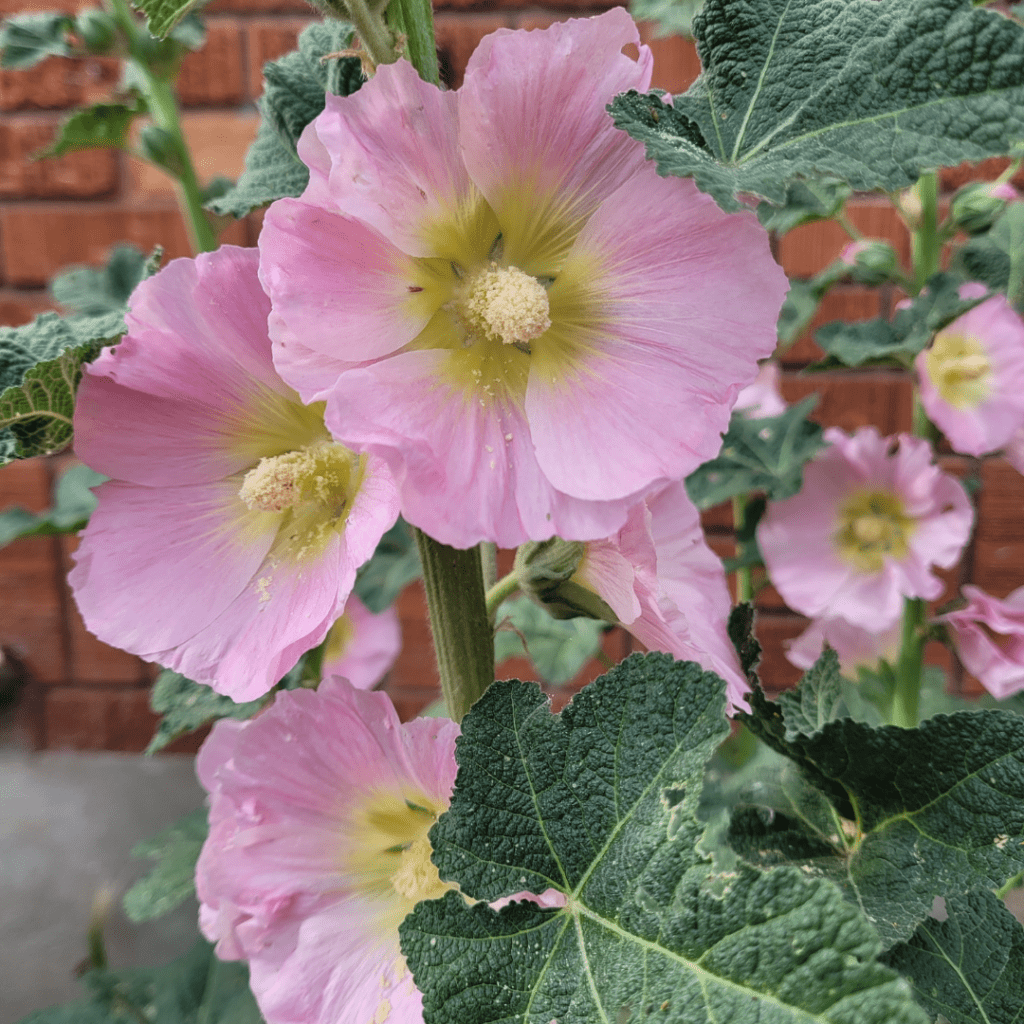
Let’s talk dirt, water, and all things eco-friendly. To keep your garden in tip-top shape, focusing on sustainable practices will not only benefit your plants, but also Mother Earth.
Organic Soil Preparation and Fertilization
Give your flowers a solid start by prepping that soil like a boss. Opt for organic materials to nourish your soil with the good stuff. From compost to natural fertilizers, your plants will thank you with vibrant blooms and luscious leaves.
Preparing organic soil and fertilizing your flower garden is essential for promoting healthy plant growth and vibrant blooms while minimizing environmental impact.
Step-By-Step Guide to Organic Soil Preparation and Fertilization
- Soil Testing: Start by testing your soil to determine its pH level and nutrient content. Soil testing kits are available at garden centers, or you can send a soil sample to a professional lab for analysis. This information will guide your soil amendment and fertilization efforts. You can even perform a simple garden soil test yourself by learning how to do it in my tutorial post, 4 Easy DIY Garden Soil Tests to Do Now.
- Organic Matter Addition: Incorporate organic matter into the soil to improve its structure, fertility, and moisture retention. Compost, aged manure, leaf mold, and shredded leaves are excellent sources of organic matter. Spread a layer of compost or organic material over the soil surface and incorporate it into the top few inches of soil using a garden fork or tiller. Here are more posts about improving your garden soil. How to Fix Sandy Garden Soil with These Effective Organic Amendments, How to Install a Worm Tunnel and Improve Your Garden Soil, How to Start Composting for the Garden: A Step-by-Step Guide
- Mulching: Apply a layer of organic mulch, such as shredded bark, straw, or compost, around your flower plants. Mulch helps conserve soil moisture, suppresses weed growth, and adds organic matter to the soil as it decomposes. Leave a gap between the mulch and the base of the plants to prevent stem rot and promote air circulation. Here is a post discussing the benefits of my favorite mulching technique. Why Cedar Mulch Is The Perfect Natural Weed Barrier.
Fertilizing Your Garden Soil
- Natural Fertilizers: Use natural, organic fertilizers to provide essential nutrients to your flower garden without synthetic chemicals. Options include compost tea, fish emulsion, seaweed extract, bone meal, blood meal, and alfalfa meal. Follow package instructions for application rates and frequency, and avoid over-fertilizing, which can lead to nutrient imbalances and environmental pollution. Learn more about fertilizing your garden soil in my post to further help you improve your garden soil. Compost or Fertilizer: Dirty Secrets of Which Is Better?
Caring for Your Flower Garden
- Cover Crops: Consider planting cover crops, such as clover or legumes, in the offseason to improve soil fertility, suppress weeds, and prevent erosion. When these cover crops are tilled back into the soil, they add organic matter and nutrients, enriching the soil for future plantings.
- Crop Rotation: Rotate your flower crops annually to prevent nutrient depletion and soil-borne diseases. By planting different types of flowers in the same area each year, you can maintain soil health and fertility while minimizing pest and disease problems.
- Beneficial Microorganisms: Incorporate beneficial microorganisms, such as mycorrhizal fungi and beneficial bacteria, into the soil to improve nutrient uptake and plant health. These microorganisms form symbiotic relationships with plant roots, enhancing soil fertility and resilience.
- Watering Practices: Maintain proper watering practices to ensure that your flower plants receive adequate moisture without waterlogging the soil. Water deeply and infrequently to encourage deep root growth and drought tolerance. Consider using drip irrigation or soaker hoses to deliver water directly to the root zone and minimize water waste.
By following these organic soil preparation and fertilization practices, you can create a healthy, sustainable flower garden that thrives without synthetic chemicals, while promoting soil health and biodiversity.
Watering Techniques for Healthy Plants
Water is the elixir of life for plants (and humans too, let’s face it). Mastering the art of watering – not too much, not too little – will keep your flowers hydrated and thriving. Whether it’s a gentle sprinkle or a deep root soak, find the watering technique that works best for your garden oasis.
Watering is a critical aspect of maintaining a healthy flower garden, as proper hydration ensures optimal growth and blooming.
Watering Techniques to Help You Achieve a Lush and Vibrant Garden
- Water Deeply and Infrequently: Instead of frequent shallow watering, aim to water your flower garden deeply, but less often. Deep watering encourages plants to develop deep root systems, which makes them more resilient to drought and heat stress. Water should penetrate the soil to a depth of 6 to 8 inches for most flowers.
- Water Early in the Day: Water your flower garden in the early morning, ideally before 10 a.m. This allows plants to absorb moisture before the heat of the day evaporates it, reducing water loss and minimizing the risk of fungal diseases.
- Use Drip Irrigation or Soaker Hoses: Drip irrigation systems and soaker hoses deliver water directly to the root zone of plants, minimizing water waste and reducing the risk of leaf diseases. These systems are particularly useful for flower beds and garden borders, as they ensure even moisture distribution without wetting the foliage.
- Avoid Overhead Watering: While overhead sprinklers are convenient, they can wet the foliage of flowers, increasing the risk of fungal diseases such as powdery mildew and botrytis. Whenever possible, water the soil directly at the base of plants to keep the foliage dry.
Maintaining Moisture In Your Garden Beds
- Mulch Beds: Apply a layer of organic mulch, such as shredded bark or compost, around your flower plants. Mulch helps conserve soil moisture by reducing evaporation, regulates soil temperature, and suppresses weed growth. Keep the mulch layer 2 to 4 inches thick and leave a gap between the mulch and the base of plants to prevent stem rot.
- Monitor Soil Moisture: Regularly check the soil moisture levels in your flower garden to ensure plants are receiving adequate hydration. Insert your finger into the soil near the base of plants to gauge moisture levels. If the soil feels dry to the touch, it’s time to water. Avoid watering if the soil is still moist.
- Water Newly Planted Flowers Carefully: Newly planted flowers have shallow root systems and require extra care when watering. Keep the soil consistently moist, but not waterlogged during the establishment period. Water newly planted flowers more frequently until they establish strong root systems.
- Adjust Watering Based on Weather Conditions: Adjust your watering schedule based on weather conditions, such as rainfall, temperature, and humidity. During hot, dry periods, you may need to water more frequently, while cooler, rainy weather may require less supplemental irrigation.
By implementing these watering techniques, you can ensure that your flower garden receives the hydration it needs to thrive, promoting healthy growth and abundant blooms throughout the growing season.
Implementing Effective Garden Maintenance Practices
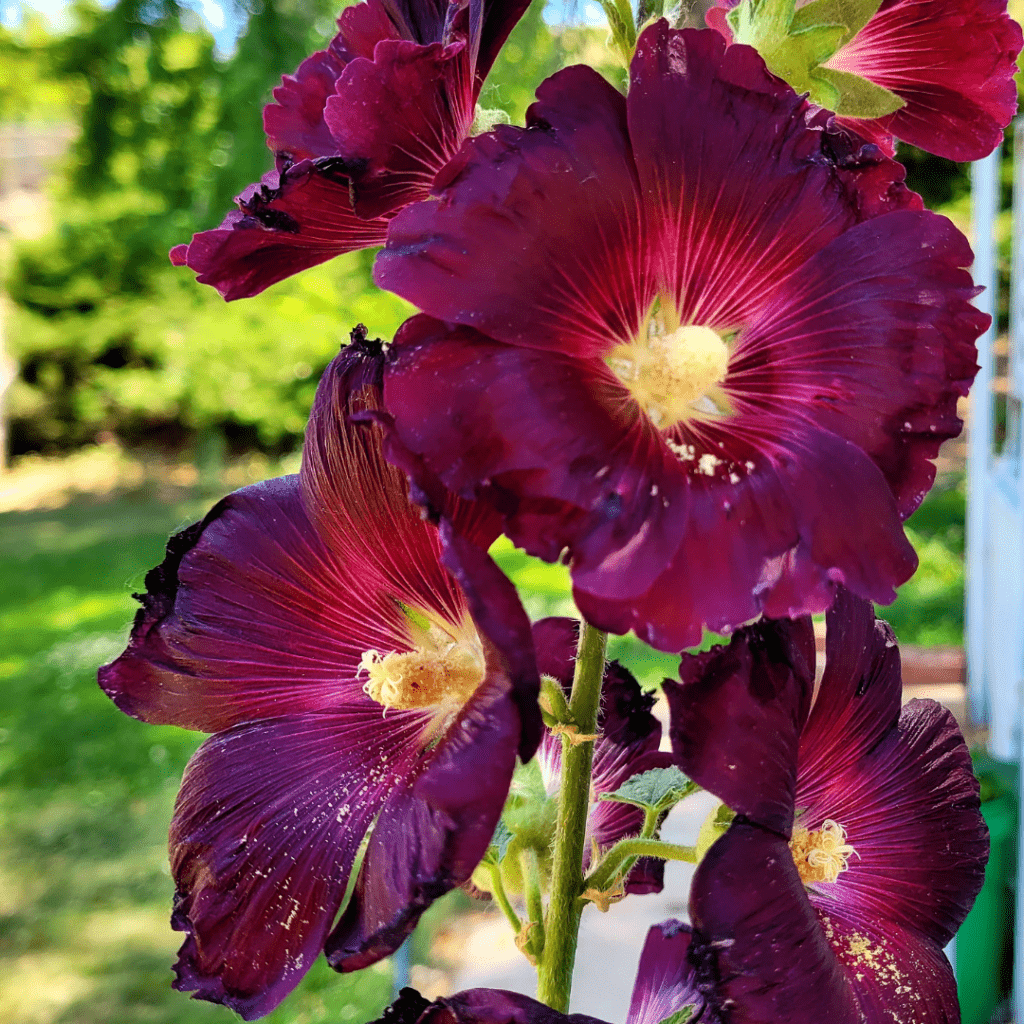
Keeping your garden in shipshape condition involves a touch of elbow grease and some savvy gardening know-how. Don’t sweat the small stuff with these maintenance tips to keep your garden looking spick and span!
Weeding and Pest Control Strategies
Ah, the eternal battle against weeds and pesky garden invaders. Arm yourself with the right tools and tactics to keep those unwanted guests at bay. From mulching to natural pest deterrents, you’ve got this garden warfare under control.
Weeding and pest control are essential aspects of maintaining a healthy and thriving flower garden. Here are some strategies to help you effectively manage weeds and pests while minimizing the use of synthetic chemicals:
Weed Control
- Mulching: Apply a layer of organic mulch, such as shredded bark, straw, or compost, around your flower plants. Mulch helps suppress weed growth by blocking sunlight and preventing weed seeds from germinating. Keep the mulch layer 2 to 4 inches thick, and replenish it as needed to maintain effectiveness.
- Hand Pulling: Regularly inspect your flower garden for weeds and hand pull them as soon as you spot them. Be sure to remove weeds by the root to prevent regrowth. This method is particularly effective for controlling weeds in small or densely planted areas.
- Cultivation: Use a hand hoe or cultivator to loosen and remove weeds from the soil surface. Cultivating the soil disrupts weed growth and exposes weed seedlings to drying air and sunlight, inhibiting their growth.
- Weed Barrier Fabric: Consider using weed barrier fabric or landscape fabric in flower beds and borders to suppress weed growth. Cut holes in the fabric to plant flowers, and cover the fabric with a layer of mulch for aesthetic appeal.
- Pre-emergent Herbicides: If necessary, use organic pre-emergent herbicides containing ingredients like corn gluten meal or corn starch to prevent weed seeds from germinating. Apply these products according to package instructions before weed seeds have a chance to sprout.
Pest Control
- Encourage Beneficial Insects: Attract natural predators such as ladybugs, lacewings, and predatory wasps to your flower garden by planting nectar-rich flowers and providing habitats such as flowering herbs, shrubs, and insect hotels. Beneficial insects help control pest populations by preying on aphids, caterpillars, and other garden pests.
- Handpicking: Regularly inspect your flower plants for signs of pest infestation, such as chewed leaves, holes, or visible insects. Handpick pests like caterpillars, beetles, and snails, and drop them into a bucket of soapy water to drown them.
- Organic Sprays: Use organic insecticidal sprays containing ingredients such as neem oil, insecticidal soap, garlic, or pyrethrin to control pest populations. These products are effective against aphids, spider mites, thrips, and other common garden pests and are less harmful to beneficial insects and the environment.
- Companion Planting: Plant companion flowers and herbs that repel pests or attract beneficial insects. For example, marigolds repel nematodes, while lavender and mint deter aphids and whiteflies. Planting a diverse mix of flowers and herbs can help create a balanced ecosystem that naturally controls pests.
- Crop Rotation: Rotate flower crops annually to disrupt pest life cycles and reduce the buildup of pest populations in the soil. Avoid planting flowers from the same family in the same location year after year to minimize pest and disease problems.
- Physical Barriers: Protect vulnerable flower plants from pest damage by using physical barriers such as row covers, netting, or floating row covers. These barriers prevent pests like birds, rabbits, and deer from accessing your flowers while still allowing sunlight and airflow.
By implementing these weeding and pest control strategies in your flower garden, you can maintain a healthy and beautiful garden without relying heavily on synthetic chemicals, promoting biodiversity and environmental sustainability.
Pruning and Deadheading for Continued Growth
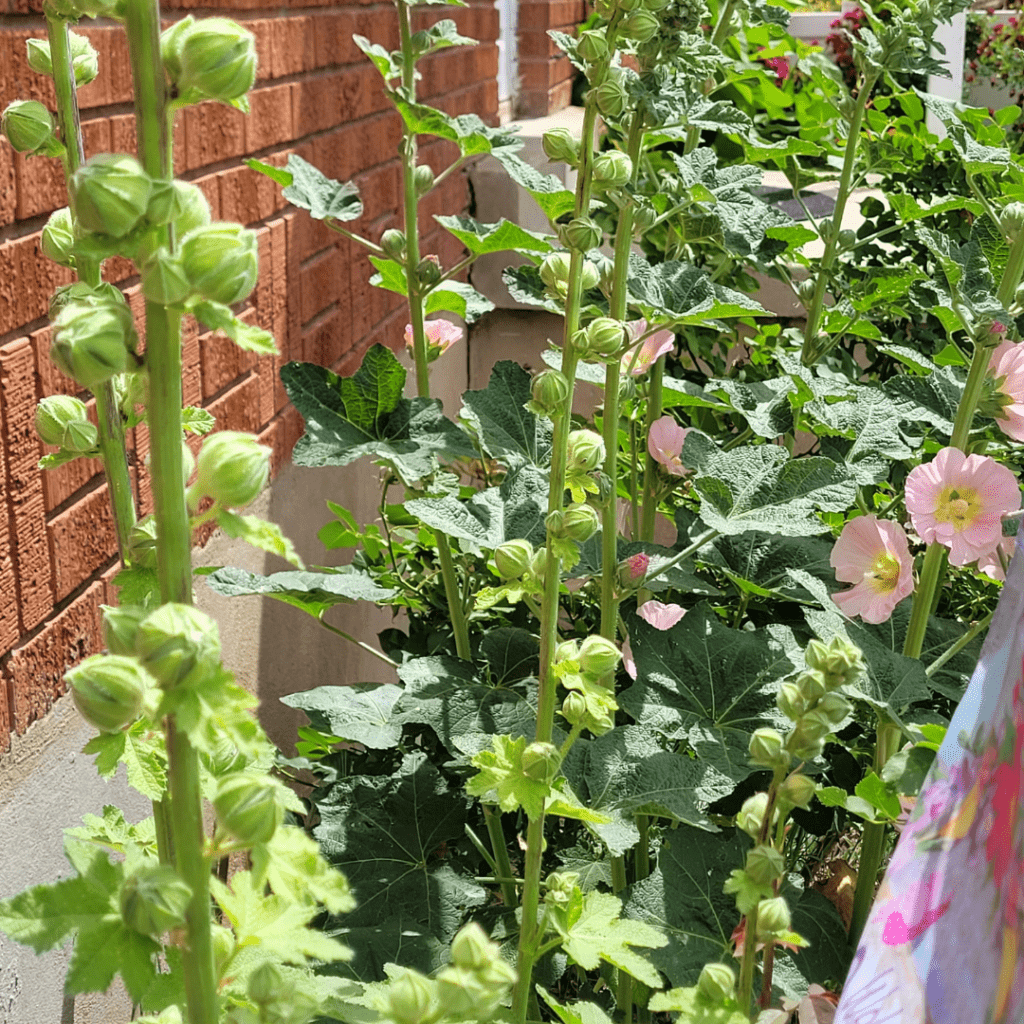
I hate to do it, but a fabulous haircut for your plants, pruning, and deadheading are essential for promoting new growth and maintaining plant health. Snip away those wilted blooms and overgrown branches to keep your garden looking fresh and flourishing. I do keep beautifully intact spent blooms for crafting, otherwise, if the blooms are too wilted, into the compost they go!
Pruning and deadheading are important practices for maintaining the health, appearance, and continued growth of flowering plants in your garden. Here’s how to effectively prune and deadhead flowers:
Pruning
- Remove Dead or Diseased Growth: Regularly inspect your flowering plants for dead, damaged, or diseased stems, leaves, and flowers. Use clean, sharp pruning shears to carefully remove any dead or unhealthy growth to prevent the spread of disease and encourage new growth.
- Encourage Bushier Growth: To encourage bushier growth and increased flowering, selectively prune back long or leggy stems. Cut back stems to just above a set of healthy leaves or a node, where new growth will emerge. This stimulates branching and results in a fuller, more compact plant.
- Shape and Control Size: Prune flowering shrubs and perennials to maintain their desired shape and size. Remove overgrown or unruly branches to improve air circulation, promote sunlight penetration, and prevent overcrowding. Pruning can also help rejuvenate older plants and stimulate new growth.
- Prune After Flowering: For plants that bloom on old wood (last season’s growth), such as lilacs and hydrangeas, prune them immediately after flowering. This allows the plant to produce new growth and set flower buds for the following year without cutting off the next season’s blooms.
- Timing: While routine deadheading can be done throughout the growing season, major pruning should generally be done during the dormant season or immediately after flowering, depending on the plant’s flowering habit.
Deadheading
- Remove Faded Flowers: Deadheading involves removing spent or faded flowers from flowering plants to promote continuous blooming and prevent seed production. Use your fingers, scissors, or pruning shears to snip off the flower heads just above a set of healthy leaves or a node.
- Encourage Repeat Blooms: Deadheading encourages flowering plants to redirect energy from seed production to new growth and flower development. By removing spent blooms, you stimulate the plant to produce additional flowers, extending the blooming period throughout the growing season.
- Prevent Self-Seeding: Deadheading prevents flowering plants from self-seeding and potentially becoming invasive or overcrowding other plants in your garden. By removing spent flowers before they develop seeds, you can control the spread of self-seeding plants and maintain a tidy appearance in your garden beds. But I absolutely love it when they spread their seeds!
- Regular Maintenance: Deadhead flower plants regularly throughout the growing season, especially for prolific bloomers like annuals, perennials, and roses. Check your plants weekly for spent flowers and remove them promptly to encourage continuous flowering and maintain the plant’s overall health and appearance.
- Selective Deadheading: While deadheading, be selective about which flowers to remove. Focus on removing spent blooms while leaving developing flower buds intact to ensure a steady supply of new blooms throughout the season.
By incorporating pruning and deadheading into your gardening routine, you can promote healthy growth, prolong flowering, and enhance the overall beauty of your flower garden.
Enhancing Your Garden with Creative Design Elements (Let the Fun Begin!)
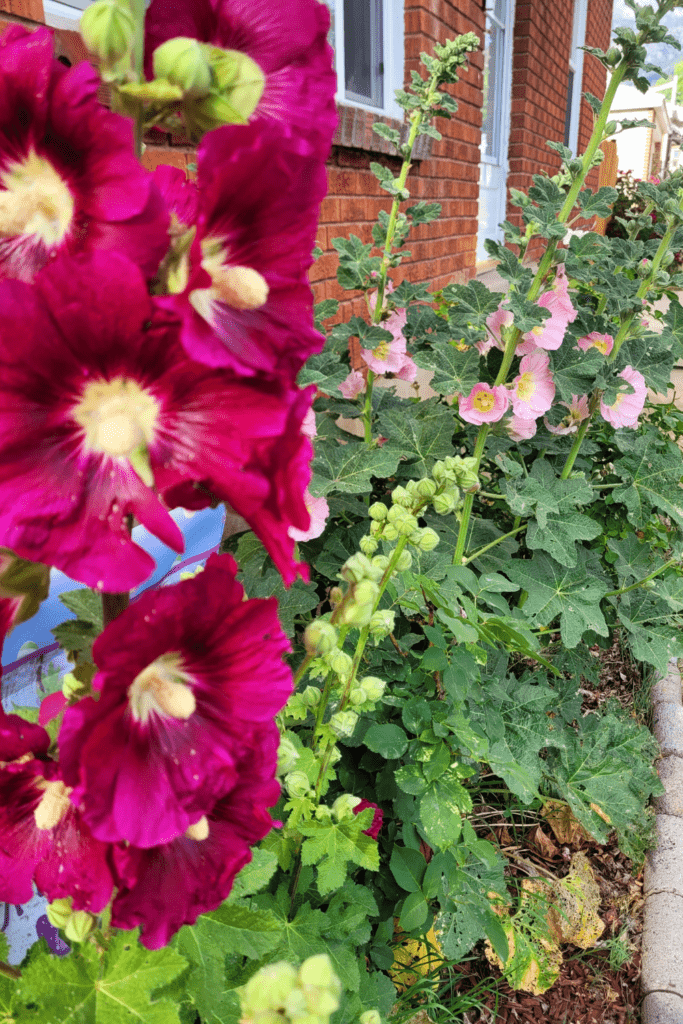
Utilizing Color Schemes and Plant Combinations
Floral Color Wheel Printable
Don’t worry, it’s FREE! I made it just for you to help you plan your flower garden!
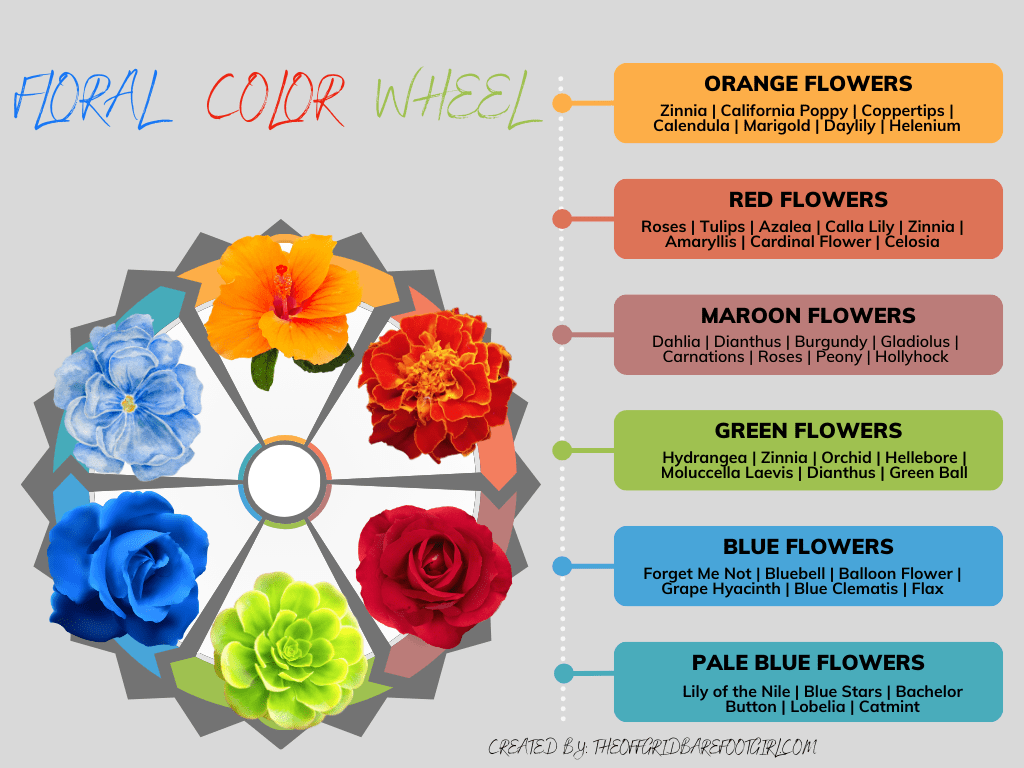
When it comes to creating a dream flower garden, think of yourself as a botanical Picasso. Mix and match different plant colors and textures to create a masterpiece that bursts with life and vibrancy.
Pro Tip: Consider using the color wheel to guide your choices and create harmonious combinations that will make your garden pop. Grab the FREE Floral Color Wheel Printable above I created!
Utilizing Floral Color Schemes
Utilizing color schemes and plant combinations in a flower garden can create stunning visual effects, evoke specific moods, and enhance the overall design aesthetic. Here’s how to effectively use color schemes and plant combinations in your garden:
- Choose a Color Scheme: Start by selecting a color scheme for your flower garden. Consider the mood or atmosphere you want to create and your personal preferences. Common color schemes include:
- Monochromatic: Using variations of a single color (e.g., different shades of blue or pink) for a harmonious and calming effect.
- Analogous: Combining colors that are adjacent to each other on the color wheel (e.g., purple, blue, and pink) for a cohesive and soothing palette.
- Complementary: Pairing colors that are opposite each other on the color wheel (e.g., purple and yellow, or red and green) for vibrant contrast and visual interest.
- Triadic: Select three colors evenly spaced around the color wheel (e.g., purple, orange, and green) for a balanced and dynamic look.
- Consider Plant Characteristics: When choosing plants for your garden, consider their characteristics such as height, texture, shape, and bloom time. Aim for a mix of flowers with different growth habits (e.g., tall spikes, mounding forms, trailing vines) and bloom shapes (e.g., daisy-like, bell-shaped, spiky).
- Create Focal Points: Use plants with bold colors or unique textures as focal points in your garden beds or containers. These focal points draw the eye and serve as visual anchors, creating depth and interest in the garden.
- Layer Plants: Arrange plants in layers according to their height and growth habits to create visual depth and dimension in your garden. Place taller plants towards the back or center of beds, with medium-height plants in the middle, and low-growing or trailing plants at the front or edges.
Plan for a Succession of Blooms!
- Consider Bloom Time: Select a mix of plants with varying bloom times to ensure continuous color and interest throughout the growing season. Choose early, mid, and late-blooming flowers to create a succession of blooms from spring to fall.
- Balance Warm and Cool Colors: Strike a balance between warm and cool colors in your garden to create harmony and visual appeal. Warm colors like red, orange, and yellow create energy and excitement, while cool colors like blue, purple, and green have a calming and soothing effect.
- Experiment with Texture and Form: Incorporate plants with different foliage textures (e.g., fine, medium, coarse) and forms (e.g., upright, mounding, spreading) to add contrast and visual interest to your garden design. Mix flowers with grasses, ferns, and ornamental foliage plants for added texture and dimension.
- Consider the Surroundings: Take into account the surrounding landscape, architecture, and hardscape elements when designing your flower garden. Choose plant colors and combinations that complement the existing features and enhance the overall aesthetic of your outdoor space.
By carefully selecting plants and arranging them according to color schemes and combinations, you can create a visually stunning flower garden that delights the senses and provides year-round beauty and interest. Don’t be afraid to experiment with different colors, textures, and arrangements to find the perfect combination for your garden.
Incorporating Hardscaping and Garden Structures
Gardens are like the cherry on top of the sundae – they’re great, but they’re even better with a little something extra. Add some hardscaping elements like trellises, pathways, or garden structures to provide visual interest and structure to your garden. Not only will they enhance the overall look, but they can also serve practical purposes like supporting climbing plants or providing a cozy nook to sip your morning coffee!
Dealing with Common Flower Garden Challenges
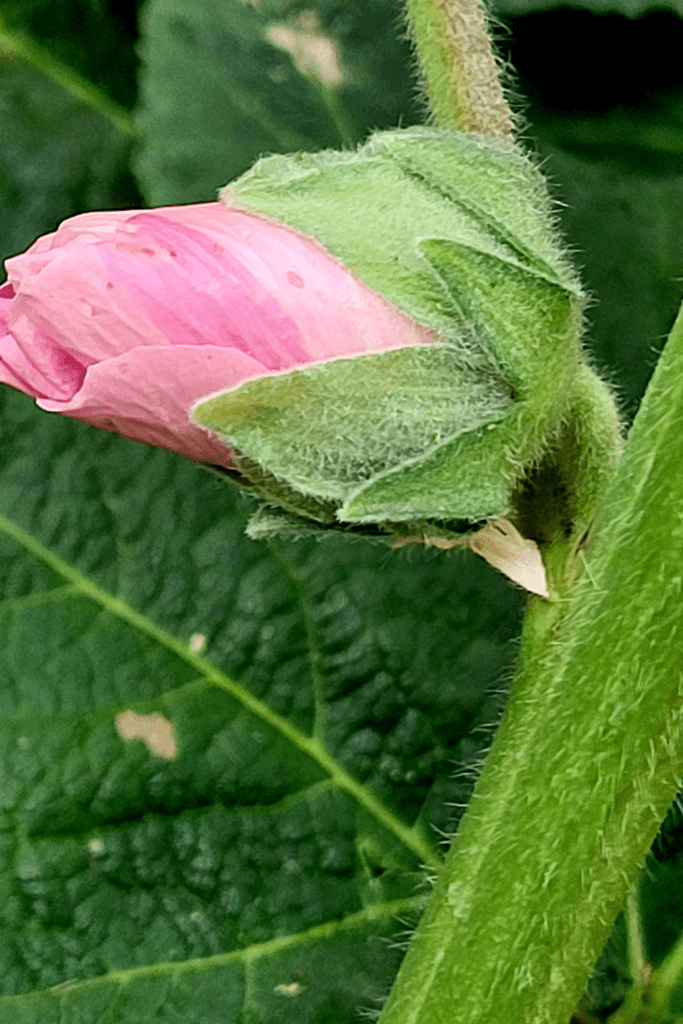
Managing Disease and Plant Health Issues
Dealing with plant diseases can feel like playing a never-ending game of Whack-a-Mole. To keep your flower garden in tip-top shape, stay vigilant and inspect your plants regularly for any signs of trouble. Practice good garden hygiene, like proper spacing between plants, and consider using organic treatments to combat pesky pests and diseases.
Addressing Common Problems In a Flower Garden
- Start with Healthy Plants: Begin with healthy, disease-resistant plants from reputable sources. Inspect plants carefully before purchasing to ensure they are free from signs of disease, pests, or stress.
- Practice Good Garden Hygiene: Keep your flower garden clean and tidy by removing dead or diseased plant material, fallen leaves, and debris regularly. Prune out infected branches and stems promptly to prevent the spread of disease.
- Water Wisely: Water your flower garden early in the day to allow foliage to dry quickly and minimize the risk of fungal diseases. Avoid overhead watering, which can wet the foliage and promote disease development. Water at the base of plants using drip irrigation or a soaker hose to keep foliage dry.
- Improve Air Circulation: Plant flowers with adequate spacing to allow for good air circulation between plants. Prune back overgrown or crowded growth to reduce humidity and prevent fungal diseases such as powdery mildew and botrytis.
- Mulch Beds: Apply a layer of organic mulch, such as shredded bark or compost, around your flower plants to suppress weeds, conserve soil moisture, and regulate soil temperature. Mulch also helps prevent soil-borne diseases by reducing splashing of soil onto plant foliage.
Practicing Crop Rotation and Organic Controls In the Flower Garden
- Rotate Crops: Avoid planting flowers from the same family in the same location year after year to prevent the buildup of soil-borne diseases. Rotate your flower crops annually to different areas of the garden to minimize disease pressure and maintain soil health.
- Monitor for Pests and Diseases: Regularly inspect your flower plants for signs of pests, diseases, or stress. Look for symptoms such as discolored or distorted leaves, wilting, stunted growth, or unusual spots or lesions. Early detection allows for prompt intervention and management.
- Use Organic Controls: Utilize organic methods to control pests and diseases in your flower garden whenever possible. Options include insecticidal soaps, neem oil, horticultural oils, botanical extracts, and biological controls such as beneficial insects or nematodes. Follow product labels carefully and apply treatments as needed, taking care to minimize harm to beneficial insects and pollinators.
- Maintain Nutrient Balance: Ensure your flower plants receive adequate nutrition by amending the soil with organic matter and providing balanced fertilization. Healthy plants are better able to resist disease and recover from stress.
By implementing these strategies for managing disease and plant health issues in your flower garden, you can promote a vibrant and resilient garden that thrives throughout the growing season. Regular monitoring, proper cultural practices, and timely intervention are key to maintaining plant health and preventing the spread of diseases.
Handling Extreme Weather and Environmental Factors
Mother Nature can be both a friend and a foe to your flower garden. From scorching heat waves to unexpected frosts, be prepared to face the elements head-on. Consider using protective measures like row covers or mulching to shield your plants from extreme weather conditions. And remember, a little TLC can go a long way in helping your garden weather the storm.
Maximizing Blooms and Flower Health
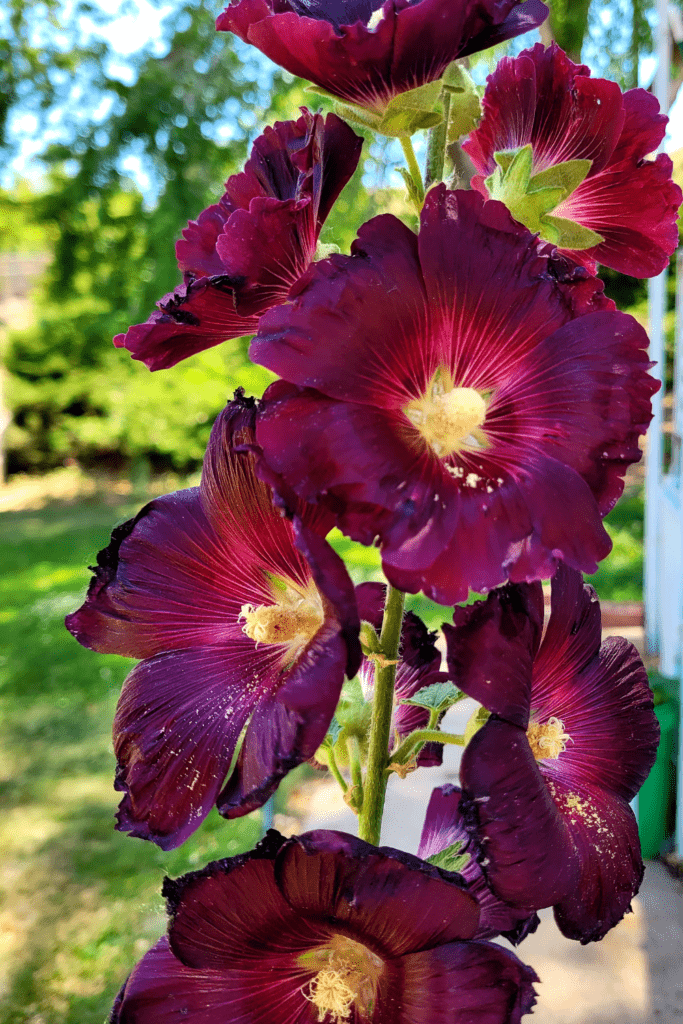
Proper Feeding and Supplemental Care
Just like us, plants need their daily vitamins and minerals to thrive. Make sure to feed your flowers with the right nutrients through fertilizers or compost. Additionally, consider providing supplemental care like deadheading spent blooms or pruning to encourage new growth and ensure a continuous display of colorful blossoms.
Encouraging Pollinators and Beneficial Insects
No garden is complete without its buzzing and fluttering visitors. Pollinators like bees and butterflies play a crucial role in pollinating flowers, ensuring a bountiful harvest. To attract these beneficial insects to your garden, plant nectar-rich flowers and provide sources of water for them to hydrate. Remember, a garden alive with pollinators is a garden in full bloom. I wrote a fun post about how to attract beneficial pollinators to your garden.
How to Attract Pollinators to Improve Your Garden Harvest
Sharing Your Flower Garden Joy with Others
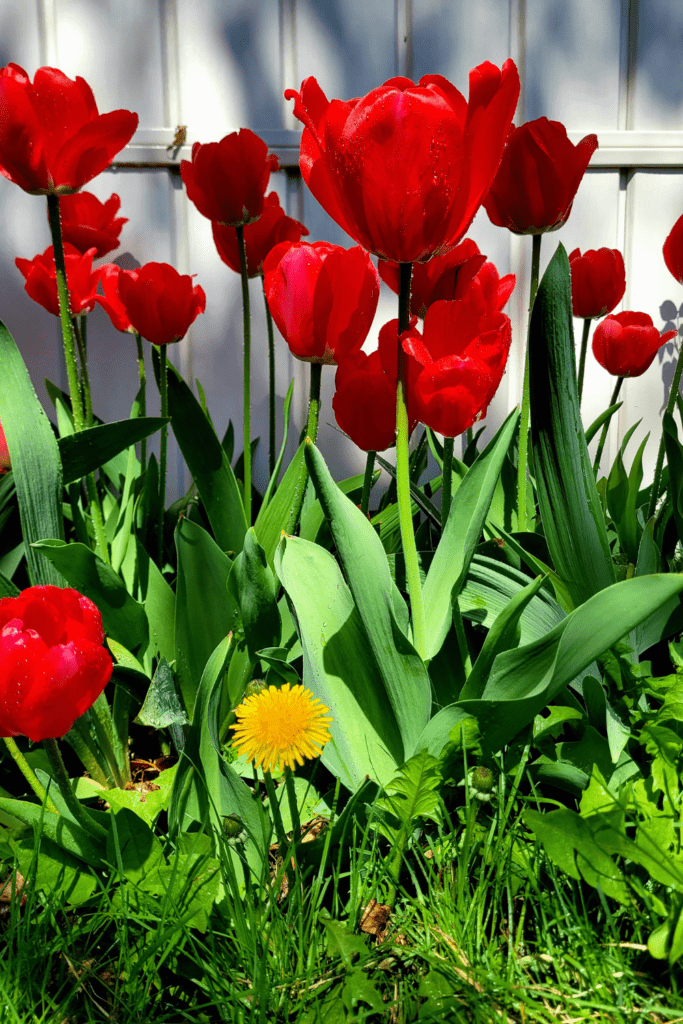
Creating Bouquets and Floral Arrangements
Why keep all the beauty to yourself when you can share it with others? Create stunning bouquets and floral arrangements from your garden blooms to brighten someone’s day or add a touch of elegance to your home. Let your creativity bloom as you mix and match different flowers and greens to create arrangements that are as unique as your garden.
Hosting Garden Tours and Events
Feeling like a proud parent showing off their child’s artwork? Why not host garden tours and events to showcase your green thumb skills and share the joy of your flower garden with others? Invite friends, family, or even your neighbors to stroll through your garden oasis, sip some lemonade, and bask in the beauty that you’ve cultivated with love and care. Better yet, create a YouTube video of your beautiful garden tour for others to enjoy! PS, I LOVE watching garden tours! If you do post a garden tour video, please leave your YouTube channel in the comments section below for me and others to check out!
Conclusion
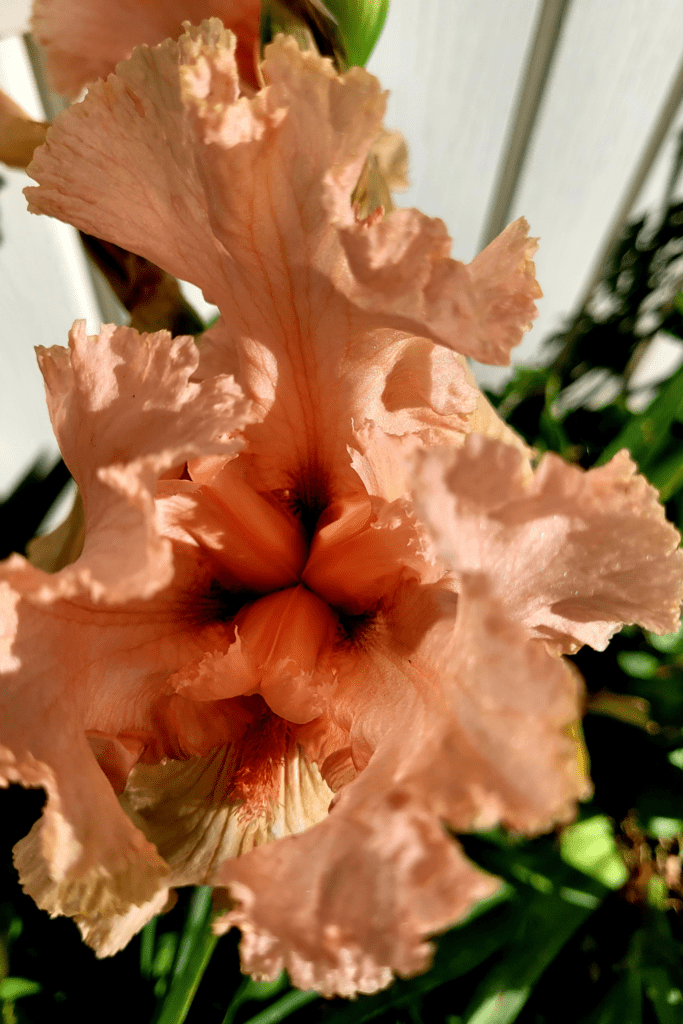
Growing your dream flower garden is not just about cultivating plants; it is a journey of creativity, patience, and love for nature. By following the guidelines and tips outlined in this ultimate guide, you are well on your way to crafting a garden that brings joy and tranquility to your life. Remember, a flower garden is a living canvas that evolves over time, so embrace the process and enjoy the beauty that each bloom brings. May your garden flourish and continue to be a source of inspiration and delight for years to come.
Resources: Here are some more resources for you to check out!
- 21 Easy Flowers for Beginners to Grow – By Garden Design
- New to Flower Gardening? Here’s Where to Start – By Longfield Gardens
- Step-by-Step: How to Start Flower Seeds Indoors – By Rooted Flowers
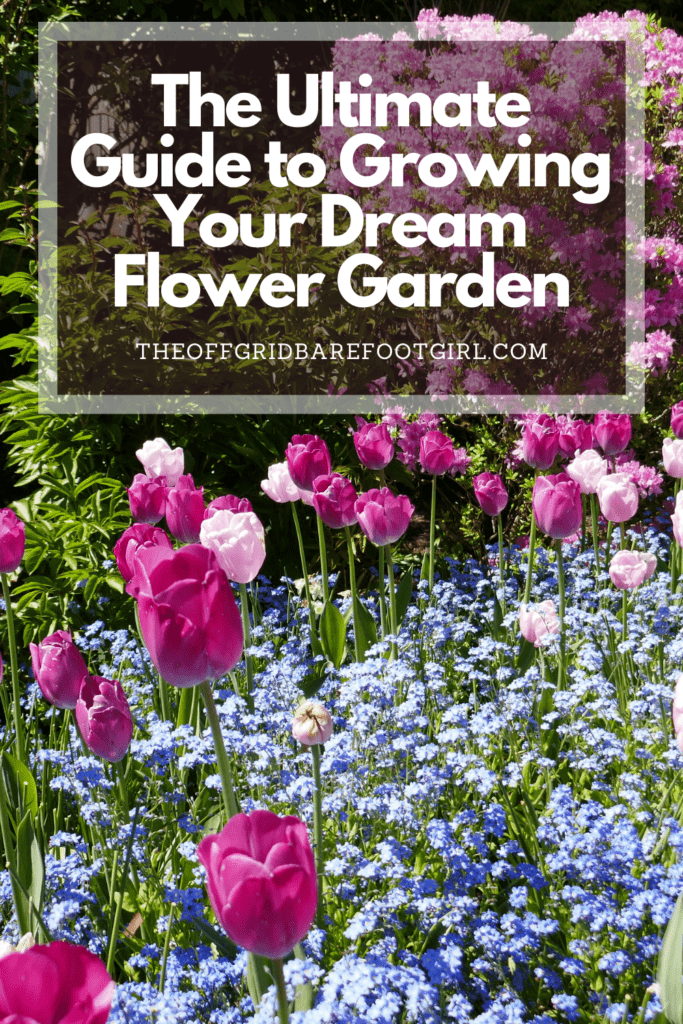
Frequently Asked Questions
1. How do I choose the right flowers for my garden?
Consider factors such as your garden’s sunlight exposure, climate, and soil conditions when selecting flowers. Choose a variety of plants that bloom in different seasons to ensure year-round color and interest in your garden.
2. What are some common maintenance tasks for a flower garden?
Regular watering, weeding, deadheading spent blooms, and fertilizing are essential maintenance tasks for a healthy flower garden. Pruning, pest control, and monitoring for signs of disease are also important to ensure your plants thrive.
3. How can I attract pollinators to my flower garden?
Planting a diverse array of flowers that offer nectar and pollen will attract pollinators such as bees, butterflies, and hummingbirds to your garden. Avoid using pesticides and provide water sources for these beneficial insects and animals.
Summary
I hope I have inspired you to grow a flower garden of your own with these tips and products.
If you were encouraged by this post, I invite you to check out my FREE Printables Page for fun free printables, planners, and charts.
ENTER MY FREE Printables Page HERE
Here are some more of my gardening inspiration posts to check out!
The Best Perennial Flowers for a Low-Maintenance Garden!
How to Design a Cottage Garden: Growing a Beautiful Mess
Roses: How to Grow and Care for Roses
Hollyhocks: How to Grow and Care for Hollyhocks
Tulips: How to Grow and Care for Tulips
PeeGee Hydrangea Trees: How to Grow and Care for a PeeGee Hydrangea Tree
Bearded Irises: How to Grow and Care for Bearded Irises
Blessings,
The Off Grid Barefoot Girl





